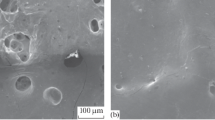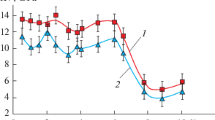Conclusions
-
1.
Alloying of high boron steels with titanium leads to the formation of high melting particles of titanium diborides in the melt and in the process of crystallization. This is accompanied by effects of incoculation and inversion which have a favorable influence on the structure and the properties of the metal.
-
2.
Enriching the melt with titanium under conditions of open, and especially plasma melting of steel, causes saturation with hydrogen; this has a deleterious influence on the homogeneity of structure of the ingots because it enhances the development of defects such as whiskers, braids, and internal cracks.
-
3.
The application of active degassing helps in suppressing the appearance and development of many defects of ingots. Degassing (dehydrogenation) of titanium containing metal is successfully attained both by melting it in vacuum furnaces and by methods of treatment outside the furnace including the addition of accurately dosed amounts of highly disperse calcium boride (CaB6) or other calcium containing compounds or hardners during pouring.
Similar content being viewed by others
Literature cited
I. M. Spiridinova, "The structure and properties of iron-boron alloys," Metalloved. Term. Obrab. Met., No. 2, 58–61 (1984).
A. K. Shurin and V. E. Pakarin, "The phase diagram of iron with interstitial phases as the basis for devising wear resistant eutectic steels," Metalloved. Term. Obrab. Met., No. 2, 55–57 (1984).
B. I. Medovar, N. I. Pinchuk, and L. V. Chekhotilo, Austenitic Boride Steels and Alloys for Welded Structures [in Russian], Naukova Dumka, Kiev (1970).
"Introducing boron- 0-a stainless steel for the nuclear industry," Stainless Steel Ind.,9, 10–11 (1959).
M. Iman, Tetsu to Hagane. J. Iron Steel Inst. Jpn,45, No. 9. 1117–1119 (1959).
V. I. Prosvirin, N. S. Kreshchanovskii, and É. S. Ginzburg, "The effect of boron on the structure and properties of austenitic steels," in: Problems of the Metal Science of Austenitic Steels, Mashgiz, Moscow (1952), pp. 185–235.
Ya. E. Gol'dshtein and V. G. Mizin, Modification and Doping of Cast Iron and Steel [in Russian], Metallurgiya, Moscow (1986).
Ya. E. Gol'dshtein, V. G. Mizin, and N. S. Khismatullina, "The modifying ability of diborides of high melting metals," Izv. Akad. Nauk SSSR, Met., No. 5, 101–106 (1987).
A. Edzhima, T. Émm, K. Suzuki, I. Hebu, and K. Sanovongi, "Criterion of uniform distribution of sulfides of REE in the crystallization of large ingots," in: Processes of Reduction and of the Formation of Nonmetallic Inclusions in Steel, Nauka, Moscow (1977), pp. 108–127.
V. M. Tageev and Yu. D. Smirnov, "Prevention of whiskers in the crystallization of steel with the aid of REE," Stal', No. 9, 823–828 (1957).
A. N. Morozov, Hydrogen and Nitrogen in Steel [in Russian], Metallurgizdat, Moscow (1968).
Additional information
Translated from Metallovedenie i Termicheskaya Obrabotka Metallov, No. 7, pp. 2–6, July, 1988.
Rights and permissions
About this article
Cite this article
Gol'dshtein, Y.E., Mizin, V.G. Some peculiarities of the structure of high boron steels. Met Sci Heat Treat 30, 479–484 (1988). https://doi.org/10.1007/BF00777432
Issue Date:
DOI: https://doi.org/10.1007/BF00777432




